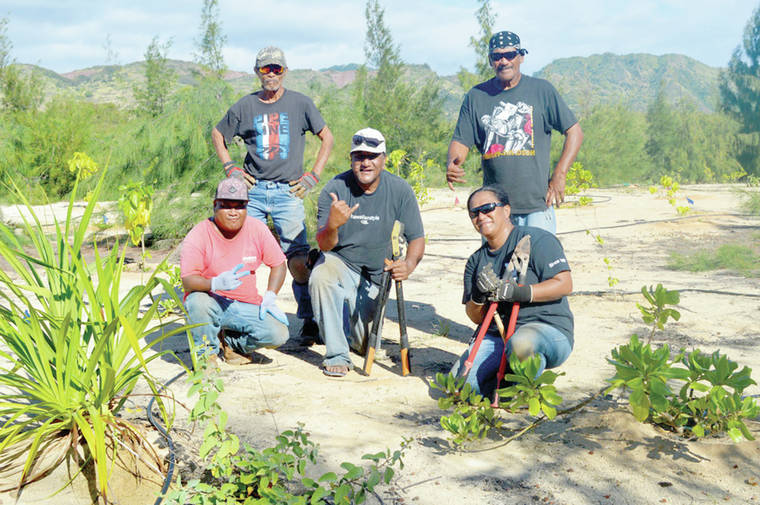PO‘IPU — For the Makauwahi Cave Reserve, nestled on the south coast of Kaua‘i in the Mahaulepu Valley close to Mahaulepu Beach, change has always been constant, even in the pre-COVID era.
The cave is Hawai‘i’s largest limestone cave, the richest fossil site in the islands, and a uniquely preserved archaeological site. The website cavereserve.org states the cave is a living museum dedicated not just to the past, but also to experiments in native-species conservation.
During the 2019 fiscal year, the Makauwahi Cave Reserve boasted over 60,000 visitors, with one-quarter of those visitors Hawai‘i residents. The rest came from all over the world.
After the pandemic, economic dynamics have significantly changed, and so has the cave’s tourist schedule, according to Manager Lida Pigott Burney.
Before COVID-19, the park was open every day of the week, but it now only offers tours Thursday through Sunday. On March, 17, like every other county tourist attraction, they were forced to shut down operations.
The park reopened June 6 on a limited basis.
CARES Act
bolsters expansion
Receiving $100,000 from a federal ARRA “stimulus package” program in 2009, the Makauwahi Cave Reserve continues to offer job-training programs.
Since the Obama
administration, the Makauwahi jobs program has operated continuously, using multiple funding sources, both public (federal, state and county) and private (foundations and companies).
Makauwahi Cave Reserve was awarded $208,000 in CARES Act funding from the County of Kaua‘i through Garden Island Resource Conservation and Development Inc. to expand the Makauwahi Jobs Program at Makauwahi Cave Reserve.
According to the county website, the funding from the county has made it possible to expand this program, creating jobs for nine more new employees.
The positions were filled in the first week of the program.
The CARES Act tourism funding allowed Makauwahi Cave Reserve to be partially funded by the Hawai‘i Tourism Authority.
The funds were allocated to projects that included: construction of a new public toilet facility with three low-impact composting toilets, improvements and extensions to the trail system and expansions of the interpretive signage.
“(This funding) has helped move along major initiatives, starting with the Wildlife Conservation Society Climate Adaptation Fund support to plant 4000 native trees and shrubs in our quarry,” Burney said. “The restoration project includes expanding our wetlands system for native waterfowl habitat.”
A wetland paradise
The Wildlife Conservation Society’s Climate Adaptation Fund is helping finance a two-year wetland-restoration project in collaboration with the landowner, Grove Farm Company, and partners in county, state and federal agencies in the private sector.
The restorations will include a new wetland and forest habitats next to the limestone quarry near the cave.
“We plan to combine sophisticated erosion-control structures with our proven methodology for creating wildlife habitat, restoring hydrological balance and nurturing even some of the rarest species of native dry-forest and wetland plants,” the website states. “The waterbirds will love it.”
With abandoned farms and quarry lands surrounding the cave, native plants and animals have returned in response to innovative restoration techniques, Burney said. Acres of restored forest land, dune vegetation and wetland habitat feature almost 100 species of native plants, including many endangered species, and even an underground ecosystem of blind cave invertebrates.
Providing relief
Before the current CARES Act funding from the County of Kaua‘i, 51 interns have participated in it over the subsequent decade.
“In the past, nearly all our participants came from the Ni‘ihau ‘ohana and other unemployed Native Hawaiians,” Burney said. “MCR has also hosted, from other funding, dozens of college-level interns and over 100 field school participants from universities throughout the world, giving these two groups of young people the opportunity for reciprocal cultural learning.”
A work in progress
The reserve currently has nine regular employees, and the funding allocated through the CARES Act has allowed them to hire nine more.
“These new, temporary employees are assisting with all phases of the work, from ground maintenance to greenhouse operations to heavy equipment operation,” Burney said. “We are planning to hire two more under the CARES Act, which will mean we will have 20 employees until the program ends Dec. 30.”
Burney hopes the additional funding will continue to provide further expansion to the cave and other jobs as well.
At the start of 2021, when the CARES Act funding expires, nothing is promised.
“If the CARES Act or something like it does not emerge in 2021, these temporary employees will be just that,” Burney said.
Visitors from throughout the world and in locally collaborate on meaningful conservation projects at the reserve, she said.
“Our offerings are participant-based, involving educational cave tours, tree-planting, cultural events and in-depth volunteer opportunities (‘voluntourism’),” Burney said.
According to Burney, donations and revenue from the tourist concessions provided a significant portion of their operating expenses.
For more information, visit the reserve and take the cave tour. Show up any time between 10 a.m. to 4 p.m. Thursday through Sunday.
Prospective visitors can get a copy of the book “Back to the Future in the Caves of Kaua‘i: A Scientist’s Adventures in the Dark,” or visit cavereserve.org or the cave’s Facebook page for brochures, videos, blogs and publications.
•••
Jason Blasco, sports reporter, can be reached at 245-0437 or jblasco@thegardenisland.com.






What’s happening with the cleanup and recovery of the POLLUTED stream? ??
The proposed dairy operations were ordered by the courts to pay (this nonprofit? ) to clean it up yet months of Surfrider Lab results report that continued dangerously high levels of bacteria sre flowing into the ocean!!!!